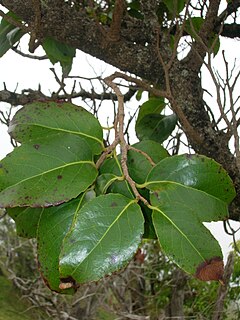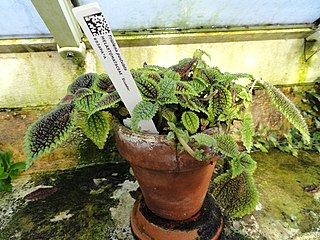
Xylosma is a genus of flowering plants in the family Salicaceae. It contains around 100 species of evergreen shrubs and trees commonly known as brushhollies, xylosmas, or, more ambiguously, "logwoods". The generic name is derived from the Greek words ξύλον (xylon), meaning "wood," and ὀσμή (osmé), meaning "smell," referring to the fragrant wood of some of the species. The Takhtajan system places it in the family Flacourtiaceae, which is considered defunct by the Angiosperm Phylogeny Group.

Gaultheria is a genus of about 135 species of shrubs in the family Ericaceae. The name commemorates Jean François Gaultier of Quebec, an honour bestowed by the Scandinavian Pehr Kalm in 1748 and taken up by Carl Linnaeus in his Species Plantarum. These plants are native to Asia, Australasia and North and South America. In the past, the Southern Hemisphere species were often treated as the separate genus Pernettya, but no consistent reliable morphological or genetic differences support recognition of two genera, and they are now united in the single genus Gaultheria.

Anthodiscus is a genus of plant in family Caryocaraceae described as a genus in 1818.

Arachnothryx is a genus of flowering plants in the family Rubiaceae. It contains about 107 species. It is found from Mexico to Peru and in Trinidad.

Helicia is a genus of 110 species of trees and shrubs, constituting part of the plant family Proteaceae. They grow naturally in rainforests throughout tropical South and Southeast Asia, including India, Sri Lanka, Indochina, Peninsular Malaysia to New Guinea and as far south as New South Wales.

Neea is a genus of plants in family Nyctaginaceae from the Caribbean region, Central and South America. Members of the genus are commonly called Nia, Neea, or saltwood.

Triolena is a genus of flowering plants in the family Melastomataceae. They are found in southern Mexico southward to Bolivia. As of 1991 there were 20 to 25 species.

Styphelia is a genus of shrubs in the family Ericaceae, native from Indo-China through the Pacific to Australia. Most have minute or small leaves with a sharp tip, single, tube-shaped flowers arranged in leaf axils and with the ends of the petals rolled back with hairs in the inside of the tube.

Trochocarpa is a genus of shrubs or small trees, of the plant family Ericaceae. They occur naturally through coastal and montane eastern Australian rainforests and mountain shrublands and in New Guinea, Borneo and Sulawesi (Malesia).
Macrohasseltia is a monotypic genus of flowering plants in the family Salicaceae. It consists of one species of tree: Macrohasseltia macroterantha, which is native to Central America. Formerly placed in the heterogeneous family Flacourtiaceae, Macrohasseltia is now classified in Salicaceae, along with close relatives Bennettiodendron, Carrierea, Idesia, Itoa, Olmediella, Poliothyrsis, and even the willows (Salix) and cottonwoods (Populus) themselves.

Bravaisia is a genus of plants in the family Acanthaceae.

Doliocarpus is a genus of flowering plants in the family Dilleniaceae, native to Central and South America.
Themistoclesia is a genus of flowering plants belonging to the family Ericaceae.

Demosthenesia is a genus of flowering plants belonging to the family Ericaceae.
Dimorphanthera is a genus of flowering plants belonging to the family Ericaceae.
Diogenesia is a genus of flowering plants belonging to the family Ericaceae.
Diplycosia is a genus of flowering plants belonging to the family Ericaceae.

Disterigma is a genus of flowering plants belonging to the family Ericaceae.













